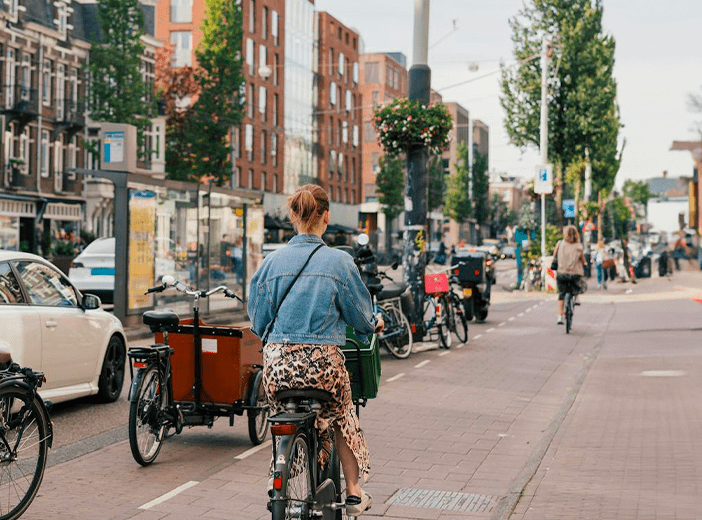Open data for better mobility in Bogota: the Movilidata project

The project hoped to highlight the tremendous power of open data to provide new insights into mobility issues by researching the case study of Bogotá.
The project hoped to highlight the tremendous power of open data to provide new insights into mobility issues by researching the case study of Bogotá. In recent decades the city earned a global reputation for its innovative transportation policies.
The Colombian capital hopes to be a leader in sustainable mobility and has prioritized public transportation and cycling over private cars. Bogotá’s iconic bus rapid transit system (BRT), the Transmilenio, and its over 400 kilometers of bike infrastructure are a testament to the city’s sustainable goals.
Project’s Steps
However, like any fast growing metropolis, Bogotá also faces numerous mobility related challenges. Our project sought to address these within the context of the new opportunities offered by Bogotá’s rapid transformation towards digital governance. Indeed, in less than a decade the number of homes with internet access in the city has more than tripled, and the municipality is working hard to ensure that digital access results in improved mobility services.
After conducting interviews with a variety of local actors, and exploring the relevant academic and press literature regarding Bogota’s transportation we identified four challenges to investigate: road congestion, air pollution, road safety and security from crime. Scholars, journalists, policy makers all recognize these issues as some of the main mobility challenges facing the capital.
We then gathered data to reveal the extent, the causes, the consequences and the potential solutions to each issue. Although Colombian legislation pertaining to Open Data is very ambitious, we faced difficulties linked to the fragmented nature of data governance. In the end, international, local, non-governmental sources helped to build a solid data library of 62 relevant data sets.
Our data analysis resulted in a large variety of graphs: comparisons across time or countries, cross references of different data sets, maps with geolocated super-imposed data sets, and so on. The dashboard we created online presents all those graphs in a user-friendly way while our white paper goes deeper into explaining each topic analysis in their policy context.
What Does Data Reveal About the Main Mobility Challenges in Bogota?
Road Congestion is one of the most serious issue Bogota’s inhabitants face on a daily basis. Bogota is the second most congested city in Latin America and the 7th in the world. Data shows how congestion culminates during peak hours on week days. It also reveals some factors that have worsened this problem in the last decade, such as the constant and rapid increase in private vehicle ownership.
Private vehicles on the roads are also largely responsible for high levels of air pollution in Bogota. At the city level, the analysis of particulate matters concentration levels reveals geographical and social inequalities. Because the wind blows from east to west, the major road axis which crosses the historical and business center stays less polluted than the eastern and poorer parts of the city.
Finally the dashboard highlights some possible solutions to achieve a more sustainable mobility model
Regarding road security, data allow to investigate the evolution across time of accidents, injured and fatal victims; to identify the places where accidents happen the most; to recognize the behavioral patterns causing accidents. Since data also reveal who is the most at risk on Bogota’s roads, authorities could target those categories in their prevention campaign to protect them more efficiently. For instance, data on accidents over the past ten years show that youth between 20 and 35 years old are the main fatal victims of motorcycle accidents.
Finally, our analysis focus on Bogotanos’ security from robbery and physical aggressions when they move through the city. This section focuses especially on gender violence and reveals patterns which could help anti-harassment policy.
What Kind of Solutions Can Data Bring?
Our complete work (link to download WP) presents a detailed analysis of the above-mentioned topics. We argue that a data-based understanding of policy issues is necessary to inform potential solutions. Each section of our work thus highlights alternatives that we identified as parts of a process to better the situation in Bogota. It also proposes a path forward that outlines policy proposals regarding open transportation data for Bogotá.
Finally, the decision to make the dashboard and the data library public and accessible by all intends to reveal how data can unleash the brainpower of active and empowered citizens to provide creative new transport solutions.
This article was written by Anouk Aflalo Doré, Luis José Guerra, Laura Meynier et Sam Whittlesey, students at Sciences Po Urban School

Every municipality and its stakeholders will benefit from effectively sharing data. However smaller, resource-constrained cities with limited budgets can find it difficult to start their data sharing programs - we look at how partnering with other local organizations can help them begin.


